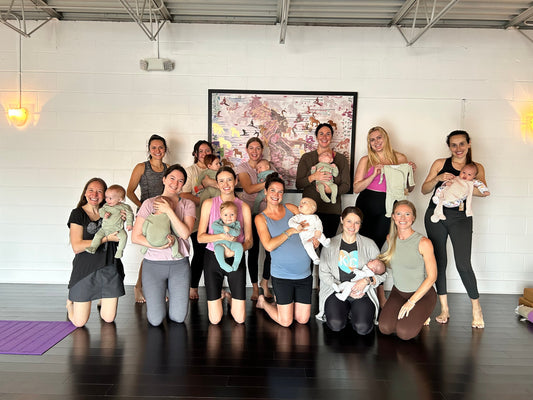Share
How to Increase Your Milk Supply
Navdeep SinghAm I making enough milk? Is my baby growing? Do I need to supplement with formula? Mama, you are not alone in these concerns and we are here to empower you to reach your breastfeeding goals.

Extensive research supports that breastfeeding is vitally important for babies’ and mothers’ health. According to the Surgeon General’s Call to Action to Support Breastfeeding, breastfeeding is recommended for at least the first year of life, and babies should be given exclusively breast milk for the first six months. Not only is it the healthiest choice physically, but breastfeeding also has psychological, environmental, and economical benefits.
Before sharing my experiences with breastfeeding or addressing a low milk supply, I want to mention some of the equitable barriers that prevent women from reaching their breastfeeding goals. In These Times reported that approximately one in four women return to work just two weeks after giving birth. Women need at least eight weeks to recover from childbirth and bond with their baby. The strong attachment between mother and baby is crucial for many reasons, one of which is to establish a good milk supply. Most moms who return to work so quickly do not do so by choice, but by necessity. Some moms also cannot afford a breast pump and don’t have insurance to provide them with one. New moms need support and resources to properly care for their baby, and these concerns should be addressed at a systematic level.
My enthusiasm for breastfeeding came as a huge surprise to me. Prior to giving birth, I thought that nursing sounded like a painful inconvenience and I didn’t anticipate lasting long. As soon as I gave birth and began nursing, I was transformed. The loving connection between my daughter and me was pure magic. Nursing felt like the most natural act in the world, and I was eager to provide my baby with all the nutrients she needed. We overcame hurdles such as blocked milk ducts, a low milk supply, and mastitis. I am proud to say that I nursed my daughter until she was 18 months old.
The Surgeon General report also states that over two-thirds of mothers stop breastfeeding after three months, and one of the leading causes is the perception of a low milk supply.
Like so many other moms, I almost began weaning my daughter when I returned to work because my milk supply was dwindling. However, I knew I was not ready to quit, and soon discovered that a few simple changes would solve my problem.
For this post I will focus on how I increased my milk supply. If these strategies don’t apply to you, or you need more information, please check out these other resources:
- Maintaining a Milk Supply
- Hidden Hindrances to a Healthy Milk Supply
Pump in the Morning
While on maternity leave, I only pumped twice in the evening. When my milk supply started decreasing, a friend suggested that I pump early in the morning. I pumped twice as much milk by making this change, and I still had plenty to nurse afterwards. This adjustment kept our freezer stocked. I made the most milk first thing in the morning because it directly followed the longest stretch of time that I did not nurse; the time of day you make the most milk may be different. After I returned to work I stopped pumping in the evening so I could focus on snuggling my little girl and keeping our nursing attachment strong.
Pump and Nurse on a Consistent Schedule
My daughter was barely 5 pounds when we left the hospital, and she was hungry all the time. At first I nursed on demand as directed by her pediatrician, but as soon as she started gaining weight, I nursed on a more regular schedule. Our consistent routine increased my milk supply. For example, our schedule was to nurse first thing in the morning and then again at 9am, so every day at 9am my body knew it was time to make milk. I also learned that I needed to nurse on both breasts and completely empty each one. An empty breast told my body it was time to make more milk, and a full breast told my body to stop making milk.
Snuggles and Skin-to-Skin Contact
The many benefits of skin-to-skin contact is another miraculous way our bodies are designed for motherhood. Just being near our babies helps us to produce more milk. Michelle Finn, an International Board Certified Lactation Consultant said that “skin-to-skin contact increases oxytocin, a hormone associated with the ‘let down’ reflex. The oxytocin released during skin-to-skin holding supports bonding and reminds your body that you have a baby to feed.” Skin-to-skin contact also increases a sense of calm and patience that mothers and babies need, thus further supporting your ability to relax and lovingly nurse your little bundle of joy.

Bonsie Skin to Skin Babywear makes it easy to bond with your baby through skin-to-skin contact any time without the fuss of constantly removing clothing. It is the only babywear uniquely designed to help mothers and caregivers bond with their baby.

Hydrate and Haakaa!
Breastfeeding and pumping makes you SO THIRSTY. We took my large hospital cup home with us, and soon ordered several more, and my husband made sure there was one always full by the couch and in the nursery. (The straw and handle made it easy to drink with one hand.) Hydration and proper nutrition play a key role in milk production. Drink up, Mama!
I am still amazed that I didn’t start my breastfeeding adventure with a Haakaa pump. This is a must have item for breastfeeding moms. The Haakaa pump is a silicone breast pump that works by using natural suction. It catches the milk from one breast as you nurse on the other. No more wasted milk! Throughout the day my Haakaa pump caught enough milk for a full bottle, and it required no extra work.
Tell Your Body What to Do
When I returned to work full time, I pumped three times a day. (Remember, it is your employer's legal obligation to provide you with time to pump.) I typically produced about 5 ounces during my last pumping session, but that slowly decreased to 2 ounces. My mistake was that as soon as I was out of milk, I stopped pumping. As soon as a friend suggested that I pump for a couple of extra minutes, I began making more milk. I was literally telling my body that I needed to make more milk, and it did. (Seriously, motherhood is amazing!)
I also worried that pumping three times a day would be too exhausting and I would fall behind on work. Wrong again! Pumping made me feel so empowered because I knew that what I was doing was helping my baby girl (who I desperately missed!) even when I couldn’t be with her.
Another fantastic product is the LaVie Lactation Massager. The massager knocks out clogged ducts, speeds up milk letdown and milk flow, and reduces discomfort from engorgement. It provided me with so much relief when my milk came in, and afterwards whenever my breasts felt tender or knotted. Bonsie customers get 15% off LaVie products with code BONSIE15 , Yay!!
Conclusion
If you’re struggling with your milk supply, or any other breastfeeding barriers, ask for help! If I hadn’t reached out for help, my breastfeeding journey could have ended after three short months. I also learned to ignore advice from other moms who do not share my parenting style or understand my goals. I heard comments like this constantly: Why don't you just switch to formula? Formula is the same as breastmilk. You’re STILL breastfeeding? Like many new moms, I was anxious that I was doing something wrong, and sometimes these comments made me second guess myself or feel embarrassed, but I followed my instincts and I am so thankful I did. Seek guidance from those who support you and disregard all the other unsolicited advice. Only you know what is right for you and your baby. Have confidence in yourself and remember that your body was designed for this.
By Emily C. Shepard
I would like to introduce myself to the wonderful Bonsie community. My name is Emily Shepard and I live in the Kansas City area with my husband, our two year old daughter, and our rescue dog. We are also expecting our second daughter in November. Yay! I have three brothers and one sister, and I am in constant awe of my mom and dad for raising five children who grew up to be such close friends. I am an English teacher, writer, dog lover, reading enthusiast, (especially about all things baby!) and absolutely obsessed with motherhood. My goal is to support fellow parents by sharing my experiences and information about the many benefits of skin-to-skin contact. I am thrilled to be a part of the Bonsie team!
Special thanks to my husband for holding my hand through every breastfeeding challenge, to my sister for covering for me at work while I pumped, my mom, dad, and mother-in-law for being my biggest cheerleaders, and to Amy and Emily for providing me with much of the advice listed above. It really does take a village! Last but not least, thank you to my little brothers for editing my writing. (Even English teachers need editors.)
Sources:
U.S. Department of Health and Human Services. The Surgeon General’s Call to Action to Support Breastfeeding. Washington, DC: U.S. Department of Health and Human Services, Office of the Surgeon General; 2011. https://www.ncbi.nlm.nih.gov/books/NBK52682/ Kiefer, A. Maintaining milk supply and why some women have a harder time: Preg u. Bloomlife.
Flora, B. (2018, March 2). Hidden hindrances to a healthy milk supply. Mother and Child Health. https://www.motherandchildhealth.com/breastfeeding/hidden-hindrances-to-a-healthy-milk-supply/.
Not able to breastfeed or choose not to? That's absolutely okay! Check out our article,
Share
-
Category:
- All posts



